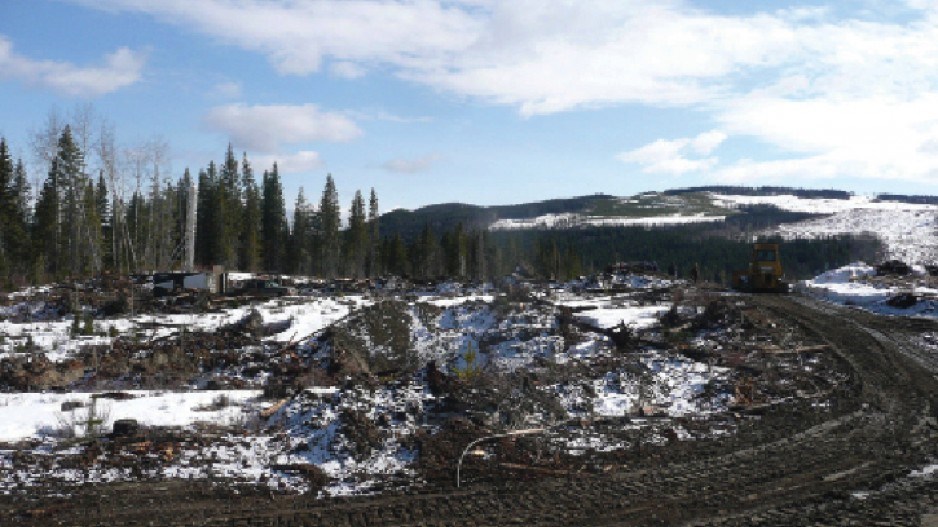While tight capital markets are taking a bite out of B.C.’s mining exploration spending this year, major global mining companies’ renewed presence in the province is cushioning the industry from darker times.
Fifty kilometres east of Williams Lake in Central B.C., the Woodjam North and Woodjam South gold-copper projects are an example of global mining capital driving a project led by a B.C. junior miner. Vancouver-based Consolidated Woodjam Copper Corp. (TSX-V:WCC) (CWC) has secured approximately $14.6 million in exploration spending on the two properties since 2009 from a sibsidiary of Johannesburg, South Africa-based mining giant Gold Fields Ltd. (NYSE:GFI). Gold Fields has committed to a further $20 million over the next four years, plus funding for a feasibility study on Woodjam South.
“The fact that, on Woodjam South, Gold Fields is carrying it right through feasibility is huge,” said Glen Garrett, a director of CWC. “Feasibilities can cost anywhere from $30 million to $100 million. If we were called to put up our share of that, how long do you think we would last? I don’t know – it’d be a lot of [share] dilution.”
The Association for Mineral Exploration BC (AMEBC) has reported a grim second quarter of 2012 for the province’s junior miners, and AMEBC president and CEO Gavin Dirom estimates that exploration activity is down approximately 30% following last year’s record $463 million spend.
However, Dirom said that, given the troubles juniors are having raising money through capital markets, things could be worse for the industry – but for the return of international heavyweights such as Gold Fields to B.C.’s market.
Dirom said through the 1990s, negative government policy and weak commodity prices triggered an exodus of the “majors” from B.C. He said a pro-mining policy shift since the early 2000s, coupled with a rise in commodity prices, is luring the majors back – most significantly in the past five years or so.
Dirom said having deep-pocketed big players around in B.C. is particularly valuable to the industry in situations such as the current capital squeeze.
“The majors typically don’t adjust their expenditures to the same extent [as smaller players],” he said, noting that large players often plan three or five years of spending at a time. “The juniors just don’t have that financial capacity, so they are looking year over year over year; they need that injection of cash and capital to do the project.”
Dirom said with the majors back in town, B.C. is being protected from the sharp drop-off in exploration that the Yukon is seeing, due to its high reliance on juniors and some intermediate miners.
“It hits [Yukon’s mining industry] very hard when the commodity markets and the capital markets dry up,” he said. “They’re going to see a substantial decrease I would suspect in their exploration expenditures compared to the proportional decrease in B.C. that will likely materialize – because we have this cushion of the majors that are going to invest $20 million to $50 million into their next advanced-stage exploration work.”
Dirom said besides Gold Fields, a notable major that’s back investing in B.C. is Xstrata PLC (LSE:XTA) of Switzerland, through its subsidiary, Xstrata Coal British Columbia.
“They’ve been quite quiet but everyone in the industry knows that they’re back – there’s just no need for them to really blow their horn about it,” Dirom said,
Mark McManus, executive general manager for Xstrata Coal Canada confirmed that the company has recently established a “significant presence” in B.C. through acquisitions including:
•the July 2011 purchase of First Coal Corp.;
•the October 2011 purchase of the Lossan coal deposit from Toronto-based Cline Mining (TSX:CMK); and
•the October 2011 purchase of the Sukunka deposit from Calgary-based Talisman Energy Inc. (TSX:TLM).
McManus said Xstrata now holds in excess of 100,000 hecatres in B.C.’s Peace River coalfield.
“Xstrata Coal,” he said, “regards Canada as an attractive location for investment with a relatively stable regulatory and fiscal regime and a long history of welcoming the benefits of mining investment.”
Dirom noted that B.C. has also attracted investment from Alabama-based coal heavyweight Walter Energy Inc.(TSX:WLT) and U.K.-based diversified mining giant Anglo American PLC (LSE:AAL).
Garratt said that besides fortifying B.C.’s mining industry against the vagaries of capital markets, the return of the majors brings other benefits for B.C.
“It brings profile,” Garratt said. “It’s a stamp of approval that you’ve got companies like [Freeport-McMoran of Canada Ltd.] and Gold Fields that are international, multinational companies viewing the exploration potential of British Columbia as highly as [that of] Chile.” •




